Extensive recent wildfires demand more stringent protection of critical old growth forest
David Lindenmayer A B and Chris Taylor A
A B and Chris Taylor A
A Fenner School of Environment and Society, The Australian National University Canberra, ACT 2601, Australia.
B Corresponding author. Email: David.Lindenmayer@anu.edu.au
Pacific Conservation Biology 26(4) 384-394 https://doi.org/10.1071/PC20037
Submitted: 21 April 2020 Accepted: 16 July 2020 Published: 12 August 2020
Journal Compilation © CSIRO 2020 Open Access CC BY-NC-ND
Abstract
Old growth forests have many key values, but temporal changes across their spatial extent are poorly understood. This includes large parts of Australia and is a major knowledge gap given the extent of human and natural disturbances in the Australian forest estate over past decades. We integrated spatial data on the timing and extent of fire and logging across mapped forest and woodland cover in different Ecological Vegetation Class (EVC) groups to quantify disturbance of the old growth forest and woodland estate in Victoria since 1995, including after the 2019–20 wildfires. We found ~77% of old growth forest and woodlands have been disturbed by fire and logging over the past 25 years. Disturbance was particularly marked in some EVCs, such as the Wet and Damp Forest and the Subalpine Woodlands. In contrast, relatively little of the Modelled Old Growth Forest and Woodland has been disturbed between 1995 and 2020 in other EVCs such as in Plains Woodlands and Heathy Woodlands. Wildfire was the primary driver of disturbance in Modelled Old Growth Forest and Woodland. We argue that a range of strategies is critical to increase protection of undisturbed old growth forest. These include re-assessing disturbance data layers to ensure that areas of old growth that have been burned at low severity are protected, and reducing the size of old growth patches to be conserved. There is also a need to increase levels of protection of young forests to enable them to grow through to an old growth state.
Additional keywords: bushfire, conservation protection, disturbance, Ecological Vegetation Classes, ecosystem, intact forest, large old trees, logging bans, mapping, old growth characteristics, Victoria, wildfire, woodland.
Introduction
The high conservation and ecosystem service values of intact forests, including those dominated by old growth stands have long been recognised in many parts of the world (Franklin et al. 1981; Scotts 1991; Bart and Forsman 1992; Spies and Franklin 1996; Van Pelt 2008; Gibson et al. 2011; Watson et al. 2018). This includes in Australia (Woodgate et al. 1994, 1996; Burgman 1996; Lindenmayer et al. 2000; Wardell-Johnson et al. 2018; Office of the Conservation Regulator 2019), where a range of studies have shown that, for example: (1) old growth stands are where fire severity is lowest relative to forests of younger age (Taylor et al. 2014; Winoto-Lewin et al. 2020); (2) bird species richness and the occurrence of individual bird species is highest (Lindenmayer et al. 2019b); (3) the abundance of large old trees (which provide key nesting and denning habitat for cavity-dependent species) is greatest (Lindenmayer et al. 2000); (4) levels of carbon storage are most substantial (Keith et al. 2009; Dean and Wardell-Johnson 2010; Dean et al. 2012); and (5) levels of water production are greatest (Watson et al. 1999).
A key part of defining old growth forest is the extent to which they have been disturbed, including the time since disturbance (reviewed by Burgman (1996)) (see following section on definitions). This is a major issue given that vast amounts of the forest estate have been disturbed in Australia in the past two decades, especially by wildfires (Lindenmayer and Taylor 2020), including those in 2019–20 (Boer et al. 2020). The extent of, and time since, disturbance therefore has substantial implications for how much old growth remains. For example, in regions such as the Central Highlands of Victoria, the impacts of past wildfires coupled with widespread logging have resulted in intact old growth forests dominated by mountain ash (Eucalyptus regnans) and alpine ash (Eucalyptus delegatensis) now constituting less than 1.16 and 0.47% of the regional extent of these ecosystems, respectively (Lindenmayer et al. 2019a). However, for many other forest and woodland ecosystems in Australia, the extent to which the old growth estate has been altered over the past few decades remains poorly known.
In the study reported here, we quantified disturbance across the extent of the old growth forest and woodland estate in Victoria. Three key questions underpinned our study. First, what has been the spatial extent of disturbance across old growth forest and woodland in the past 25 years? Second, which old vegetation types have experienced the greatest disturbance in areas of old growth? Third, which factors are the key drivers of these changes?
To answer these three questions, we used spatial data on Victoria’s vegetation classification system that is based on Ecological Vegetation Classes (EVCs) (Department of Environment and Primary Industries 2014; Department of Environment Land Water and Planning 2014a) and intersected it with data on the extent of disturbances associated with fire and logging since 1995. In discussing the findings of our spatial and temporal analyses, we argue there is an urgent need to better protect both remaining areas of old growth forest and woodland as well as areas of currently younger forest, which could be recruited as new areas of old growth in the future.
Background – definitions of old growth in Victoria
The term ‘old growth’ was an initially a descriptive term used in forestry employed from 1931 to describe stands of Douglas fir (Pseudotsuga menziesii) forest >160 years old in north-western North America (Franklin et al. 1981; Dargavel 1998). In Australia, increasing public interest during the 1980s and 1990s (Dargavel 1995), led to various working definitions of old growth forest that were, in part, based on forest type and structure (Woodgate et al. 1994, 1996; Burgman 1996; Lindenmayer and Burgman 2005). Under the National Forest Policy Statement (Commonwealth of Australia 1995), Australian Commonwealth and State governments collectively agreed to develop criteria defining old growth forests and woodlands, followed by assessments of forests and woodlands for their respective old growth values.
As a signatory to National Forest Policy Statement under the Regional Forest Agreement process, the Victorian Government undertook its first extensive study of ‘old growth’ forest and woodland in East Gippsland, in the east of the state (Woodgate et al. 1994). This initial study was then used a basis for subsequent assessments of old growth forest (Woodgate et al. 1996). These studies were influenced by the growth stages of eucalypts described by Jacobs (1955). Further work conducted in Victoria expanded these growth stages to include phases of the forest which supported senescent trees (Woodgate et al. 1996). The Victorian Government developed the following definition following the work by Woodgate et al. (1994):
Old-growth forest is forest which contains significant amounts of its oldest growth stage – usually senescing trees – in the upper stratum and has been subject to any disturbance, the effect of which is now negligible. (Department of Natural Resources and Environment 1996, p. 3)
Old growth forest and woodland was identified as vegetation containing senescing trees present in dominant, codominant, and subdominant proportions of the upper stratum. These consisted of at least 10% of total crown cover for the stand and where regrowth was sparse, consisting of less than 10% of the crown cover (Department of Natural Resources and Environment 1996). Crown cover and crown form were grouped in the following stages: juvenile, sapling, pole, early mature, mature, late mature and over-mature, and used directly to model old growth forest (Department of Natural Resources and Environment 2000). These categories corresponded to forest growth stages initially developed by (Jacobs 1955). Three categories were then developed: (1) undisturbed, in which there was no record of disturbance history; (2) negligibly disturbed, where there was some disturbance, but it did not alter the structure or floristic composition of a given EVC group; and (3) significantly disturbed forest, where disturbance was likely to have altered the composition of a EVC group (Department of Natural Resources and Environment 1996).
In particular ecosystems such as those dominated mountain ash and alpine ash forest (which are part of the Wet Damp EVC), old growth forest was deemed to occur at the onset of senescence of trees, especially the development of hollows (120+ years) (Ambrose 1982). Since the 1990s, regulations have precluded logging of old growth mountain ash and alpine ash forest in the Central Highlands of Victoria, where the majority of logging occurs in the State (Macfarlane et al. 1995). However, changes by the Victorian Government since 2013 have meant that stands of mountain ash and alpine ash trees must now be more than 250 years old to be considered to be old growth (Department of Environment and Primary Industries 2013; VicForests 2013; Blair et al. 2017). In 2019, the Victorian Government announced an immediate cessation of logging in old growth forest in Victoria (Office of the Premier of Victoria 2019); an announcement that was relevant primarily to logging of old growth forest in East Gippsland, but has implications for other parts of the state (Office of the Conservation Regulator 2019).
Methods
Background data used in spatial analyses
We used three old growth datasets in our assessment of old growth forests and woodlands in Victoria. The first was the OG100 dataset (Department of Environment, Land, Water and Planning 2014a), which identified areas of Modelled Old Growth Forest derived from both vector and grid based analysis. It delineated forest areas meeting the Victorian Government’s definition of old growth forest based on a set of modelling criteria, rules and input datasets. It was generated from a combination of regional old growth studies, including those by Woodgate et al. (1994), the Department of Natural Resources and Environment (1996), the Department of Natural Resources and Environment (1998), and the Department of Natural Resources and Environment (2000). These datasets mapped the extent of Modelled Old Growth Forest and Woodland prior to the major wildfires of 2003, 2007 and 2009.
The old growth dataset MOG2003 (Department of Environment Land Water and Planning 2014b) identified areas of Modelled Old Growth Forest and Woodland derived from both vector and grid-based analysis using disturbance data that postdates the source of old growth analyses for OG100. It considered the impacts of the 2003 wildfires using Alpine Fire Severity Mapping (2003) and logging history records that conflicted with Old Growth Forest (OG100) and these were reclassified by the Victorian Government as not being old growth forest. Following these disturbances, MOG2003 delineated old growth forest and woodland to be those areas meeting the Victorian definition of old-growth forest, as described above (Department of Natural Resources and Environment 1996, p. 3).
The MOG2009 dataset (Department of Environment, Land, Water and Planning 2019b) contained Modelled Old Growth Forest data that were updated by the Victorian Government in 2009 in consideration of historical timber harvesting and fire disturbances. Previous old growth base layers used different sources to establish the MOG2009 dataset. The base layer in the western part of the state was OG100 and the base layer for the eastern Victoria, other than East Gippsland Forest Management Area, was MOG2003. In the process of developing MOG2009, the Victorian Government amended previous old growth base layers based on logging history, extent of recent wildfires and fire severity mapping for the 2006, 2007 and 2009 wildfires. Similar to OG100 and MOG2003, old growth forest extent was identified to meet the Victorian Government’s definition of old growth forest, as described in the introduction (Department of Natural Resources and Environment 1996, p. 3).
We used the NV2005_EVCBCS dataset that mapped EVC groups across Victoria (Department of Environment, Land, Water and Planning 2019a). This dataset was designed for use at a large scale (1:25 000 to 1:100 000) and it identified combinations of Victorian bioregions and extant EVCs. The dataset underpinned the implementation of Victoria’s Native Vegetation Management Framework, which defines how the Bioregional Conservation Status of an EVC is used in determining the conservation significance for biodiversity purposes (Department of Environment, Land, Water and Planning 2019a).
We identified EVCs and areas within EVCs supporting forests and woodlands. We excluded areas broadly not supporting trees, such as grasslands scrubs and shrubland. We followed the definition of forests and woodlands used under the Nationally Agreed Criteria for the Establishment of a Comprehensive, Adequate and Representative Reserve Systems for Forests in Australia (Joint ANZECC/MCFFA National Forest Policy Statement Implementation Sub-committee 1997). This has defined a forested region as being one dominated woody vegetation with a mature or potential mature stand height exceeding 5 m, with forests containing an overstorey canopy cover greater than 20% and woodland supporting a canopy cover less than 20%.
We used a fire history dataset that contained information on the spatial extent of fires, primarily on public land across Victoria (Department of Environment, Land, Water and Planning 2019a). This dataset records the last time an area was known to be burnt by wildfire and represented a consecutive overlay of all fires recorded since 1900. The dataset does not contain information on fire severity. We obtained fire severity maps for the study area from the Victorian Government (Department of Environment and Primary Industries 2014). These maps were based on a fire severity index developed through digital processing of the pre-fire and post-fire imagery acquired by the SPOT 4 and 5 Satellite, with the magnitude of canopy damage compared against ground-based information (Department of Environment and Primary Industries 2014). This fire history dataset did not feature the extent of the wildfires burning across Victoria for the 2019–20 wildfire season. We extracted information on the spatial extent of these fires from the Emergency Victoria database (Emergency Victoria 2020).
We sourced data on the areas disturbed by logging from a Logging History dataset for any given area within State Forest (Department of Jobs Precincts and Regions 2019). This dataset stores details of the last time a forest was known to be logged, the tree species logged, and the logging method used. It represents a consecutive overlay of all years from 1961–62 to the most recent logging seasons. We selected logging years 1995–2020 for our analysis to align with the dates for which old growth assessments were conducted across Victoria.
Spatial analysis
We assessed the extent of Modelled Old Growth Forest and Woodland burnt by wildfire between 1995 and 2020. We selected 1995 as the start year because it aligned with the assessments of forest under the Victorian Government’s definition of old growth across the state. We combined the extent of wildfire areas burnt between 1995 and 2020. We identified areas burnt multiple times over the analysis period for the total area and for specific EVC groups. We present our findings as the number of hectares impacted by disturbance, either through wildfire, logging or a combination of both.
Results
Approximately 833 445 ha of old growth forest and woodland (termed Modelled Old Growth Forest and Woodland) was identified as occurring in Victoria in 1994–2000 across five study areas: East Gippsland, Central Highlands, North East Victoria, Gippsland and South Western Victoria (Department of Environment, Land, Water and Planning 2014a). Old Growth Forest modelled in these studies equated to 11% of Victoria’s total native forest and woodland cover (Department of Environment, Land, Water and Planning 2014a) (Fig. 1). Across all EVC groups consisting of forests and woodlands, we calculated the percentage of Modelled Old Growth for each EVC group across this time; where values ranged from 0.3% for Plains Woodlands and Forests to 28% for Heathy Woodlands (Fig. 2).
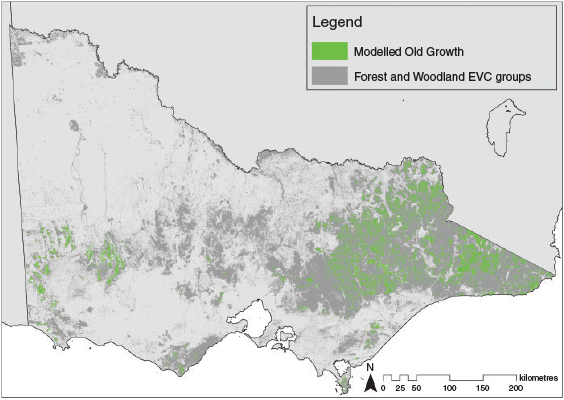
|
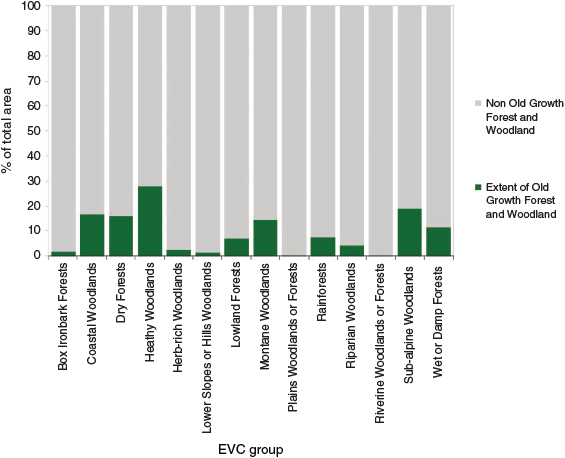
|
Across all EVC Forest and Woodland groups, we found that 638 253 ha or 77% of Modeled Old Growth Forest and Woodland was disturbed by wildfire, logging or a combination of both from 1995 to 2019–20 (Fig. 3). Of the disturbed area, around 236 085 ha or 28% of the Modelled Old Growth Forest and Woodland area has been disturbed twice or more (Fig. 4). Approximately 98% of disturbance was the result of wildfire. Logging occurred in 11 164 ha or 1.3% of the Modelled Old Growth Forest and Woodland area, with 74% of logging in Modelled Old Growth Forest and Woodland occurring in East Gippsland. Of this area in East Gippsland, we calculated 6028 ha or 73% of logging in Modelled Old Growth forest occurred in the Wet and Damp Forest EVC.
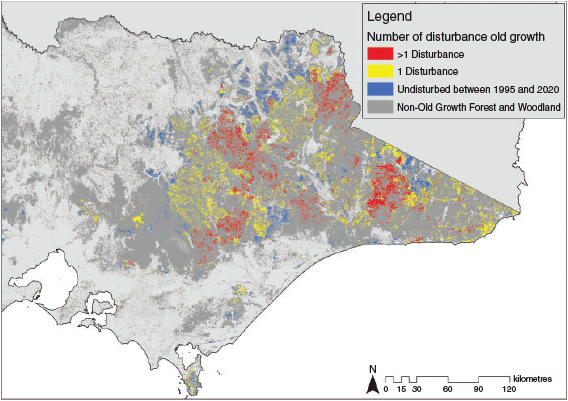
|
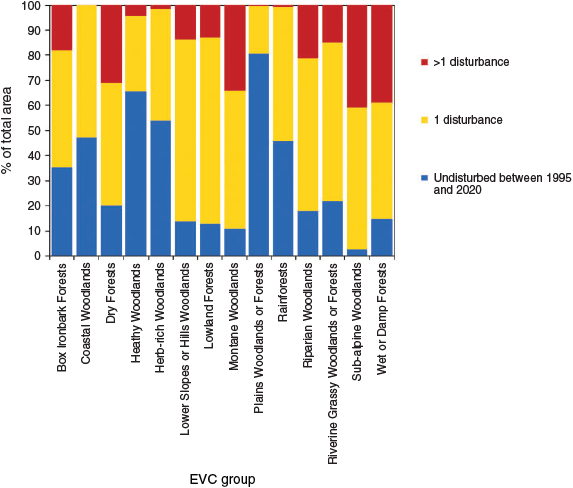
|
We found there has been extensive disturbance of Modelled Old Growth Forest and Woodland in particular EVC groups. For example, around 85% (127 000 ha) of Modelled Old Growth Wet and Damp Forest EVC has been disturbed by either logging, wildfire or both (Fig. 4). Of this, 57 914 ha or 39% of Modelled Old Growth Wet and Damp Forest has been disturbed twice or more since 1995. Modelled Old Growth Subalpine Woodland has suffered extensive disturbance, with approximately 97% of this EVC group disturbed since 1995. By contrast, the Plains Woodlands or Forests EVC and Heathy Woodlands EVC have experienced comparatively limited disturbance as a result of fire or logging (Fig. 4).
Changes to the extent of Modelled Old Growth Forest and Woodland through declassification
Following major wildfires in 2003, 2007 and 2009, the Victorian Government reviewed the extent of Modelled Old Growth Forest and Woodland previously mapped between 1994 and 2000 (Department of Environment, Land, Water and Planning 2019b). The mapped extent of Modelled Old Growth Forest and Woodland was amended to reflect disturbances by logging operations and wildfires in 2003, 2007 and 2009 (along with the severity of those fires). Fire severity is the impact of fire on vegetation (Keeley 2009) and it was assigned to one of five classes ranging from a canopy consuming fire (the most severe) to unburnt (the lowest) (Taylor et al. 2014). The Victorian Government used its definition of old growth forest and woodland it applied in the regional old growth assessments it undertook between 1994 and 2000 (described in Department of Natural Resources and Environment (1996, p. 3)) to review which areas still qualified as old growth and those that did not following disturbance by wildfire and logging (Department of Environment, Land, Water and Planning 2019b).
We found that 564 588 ha or 79% of forests and woodland previously mapped in 1994–2000 as Modelled Old Growth was declassified following wildfires and logging. This included 111 130 ha (76%) of the Wet and Damp Forest EVC, 344 117 ha (82%) of the Dry Forest EVC and 21 226 ha (99%) of the Subalpine Woodlands EVC (Fig. 5).
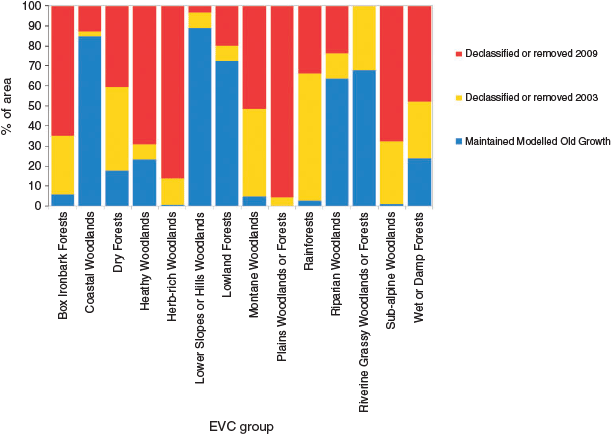
|
In the Central Highlands Old Growth study region, a total of 12 145 ha of Modelled Old Growth was burnt by the 2007 and 2009 wildfires. The 2009 review of old growth forest removed 11 518 ha from the Modelled Old Growth Forest and Woodland estate (Department of Environment, Land, Water and Planning 2014a). This included 1564 ha of Modelled Old Growth Forest and Woodland that was subject to a low severity fire with light or no crown scorch (Fig. 6). In other areas of the Central Highlands study region, we found that Modelled Old Growth Forest and Woodland was declassified in areas where no fire or logging had occurred.
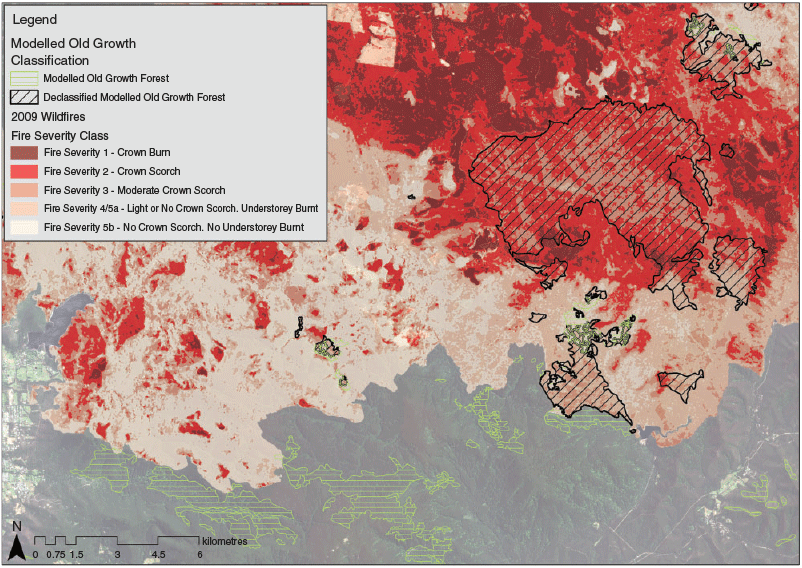
|
Discussion
Old growth forests and woodlands have a wide range of key ecological and ecosystem service values (Scotts 1991; Wardell-Johnson et al. 2018). We sought to quantify temporal changes in the spatial extent of old growth forest and woodland in different EVCs in Victoria. Our analyses revealed that fire and/or logging have dramatically reduced the extent of the Modelled Old Growth forest and woodland by 77% over the past 25 years. Although disturbance is a critical part of a forest’s or woodland’s life cycle (Lindenmayer and Burgman 2005), it is the scale and the increased frequency of disturbance across the Modelled Old Growth Forest and Woodland estate in Victoria that warrants concern. Modelled Old Growth forest and woodland has been disturbed in all EVC groups, but losses have been particularly marked in some EVCs such as the Wet and Damp Forest EVC and the Subalpine Woodlands EVC (Fig. 4). In contrast, relatively little of the Modelled Old Growth Forest and Woodland has been disturbed between 1995 and 2020 in other EVCs such as in the Plains Woodlands or Forests EVC and the Heathy Woodlands EVC.
The primary driver of decline in Modelled Old Growth Forest and Woodland was wildfire. Indeed, in some of these EVCs like the Subalpine Woodlands EVC, wildfire has disturbed all but a small fraction (~3%) of the old growth they formerly supported just 25 years ago. Moreover, many areas in this EVC have experienced multiple wildfires in that time. Notably, those EVCs that are targeted for wood production, such as the Wet and Damp Forest EVC, also have experienced substantial disturbance (again primarily as a result of wildfire) and the area of Modelled Old Growth was substantially reduced between 1995 and 2020. Some of this loss of was due to logging (primarily in East Gippsland), but the vast majority was due to wildfire.
Strategies to strengthen the protection of old growth
Given our analysis showing the increasing rarity of intact old growth forest and woodland in many EVCs in Victoria, in the remainder of this article, we discuss some of the policies and management strategies that are required in response to the extensive declines in this key growth stage of forest and woodland ecosystems.
Strengthen efforts to protect remaining areas of old growth forest and woodland
The extent of losses in Modelled Old Growth Forest and Woodland in Victoria in the past 25 years indicate a need for greater protection of the limited remaining areas in many EVC groups. The best ways to do this will vary between EVCs. For example, carefully targeted ecological burning may be appropriate to reduce the risk of high-severity wildfire in very limited remaining areas of old growth in the Subalpine Woodland EVC, the Plains Woodland and Heathy Woodland (Hobbs 2002; Lindenmayer et al. 2010). However, such kinds of management interventions are inappropriate in some forest types, in particular, the Wet and Damp EVC dominated by mountain ash and alpine ash (Lindenmayer et al. 2015). Logging in this EVC may need to be reduced, especially in places close to old growth patches because logging increases the risk of high-severity wildfire in young regrowth ash-type eucalypt forests (Taylor et al. 2014; Winoto-Lewin et al. 2020).
Additional strategies to better protect remaining old growth forest and woodland are further described below, including revisiting definitions of old growth, reducing the size of patches of old growth that are protected, and reassessing the status of old growth areas that have been subject to low severity disturbances and which continue to support the key characteristics of old growth.
Revisit the definition of old growth forest and woodland in some EVCs
Protection of old growth forest and woodland is dependent on how it is defined (Burgman 1996; Lindenmayer and Burgman 2005). Definition of old growth in some EVCs has changed in recent years (Department of Environment and Primary Industries 2013; VicForests 2013; Office of the Conservation Regulator 2019). For example, in mountain ash and alpine ash forests (within the Wet and Damp EVC), a change in definition has meant less protection for advanced growth stands (i.e. those 120–250 years old), which now require an additional 130 years of growth before prescriptions to protect them can take effect (Blair et al. 2017). This significantly weakens the protection of large old trees and, in turn, the protection of denning habitat for animal species of conservation concern like Leadbeater’s possum (Gymnobelideus leadbeateri) and the greater glider (Petauroides volans) (Blair et al. 2018). We argue that old growth stands of mountain ash and alpine ash are already rare (Lindenmayer et al. 2019a), and suggest that the Victorian Government needs to revert to the original tree age definition of 120+ years for stands to qualify as old growth. This change is important because trees occupied by arboreal marsupials of conservation concern are typically 150–170+ years old (Lindenmayer et al. 2017), and hence somewhat younger than the 250 years set out by government criteria (Department of Environment and Primary Industries 2013; VicForests 2013). This will include forests containing old growth attributes that are currently not included in the old growth estate and may be at risk from logging (Fig. 7).
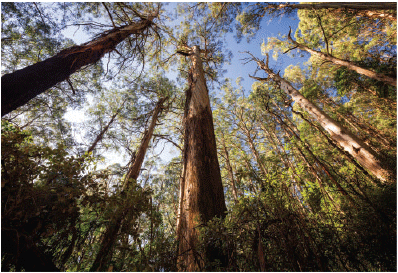
|
Consider the minimum size of old growth patches for protection
A key issue for the conservation of old growth stands is the size of patches that are targeted for protection (e.g. from logging). In mountain ash and alpine ash forests, logging was formerly excluded from patches exceeding 5 ha in size. However, in a positive move, recent protocols have reduced this to 1 ha (Office of the Conservation Regulator 2019). However, even at this reduced size, important attributes of old growth forest, such as individual large old trees, may still be lost as a result of logging operations (Lindenmayer 2017). Individual large old trees are critical habitat for a wide range of species, including arboreal marsupials and birds of conservation concern (Lindenmayer et al. 2017). There are also strong relationships between the occurrence of cavity-dependent species like Leadbeater’s possum and the greater glider and the abundance of large old trees in otherwise what are deemed to be regrowth stands (and where logging is permitted) (Lindenmayer et al. 2014). On this basis, we argue the definition of the size of old growth patches needs to be further reduced from 1 ha to a scale of an individual large old tree (defined as any stem that is 120 years or older). This change to better protect individual large old trees is especially important given the rapid rate at which existing trees are collapsing in mountain ash forests (Lindenmayer et al. 2018). We suggest that individual trees need to be protected by a buffer of unlogged forest because logging in adjacent areas and the surrounding landscape will otherwise increase rates of collapse of these trees (Lindenmayer et al. 2018).
Reassess disturbance maps
We argue there needs to be a reassessment of mapped old growth data layers and fire severity mapping to identify those areas of forest and woodland that have been subject to low severity fire. These areas should have their protection reinstated as they retain many of the key features of old growth forests (such as the persistence of large living trees). In the O’Shannassy Water Supply Catchment, which is part of a network of catchments supplying water to the City of Melbourne, the 2009 wildfires burnt large areas previously mapped as Modelled Old Growth Forest (Taylor et al. 2014) (Fig. 6). The Victorian Government’s review of Modelled Old Growth Forest and Woodlands following the 2009 wildfires declassified large areas of previously mapped as Modelled Old Growth Forest that sustained low severity fire (Fig. 8). In this case, the large and surviving old growth trees remain in this forest despite the declassification.
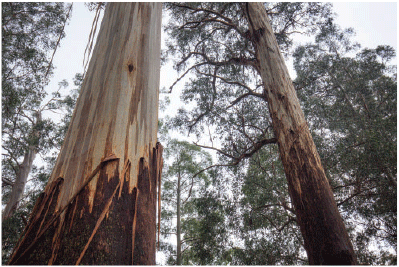
|
Increase the transparency of the delisting process for old growth forest and woodland
The rationale for delisting areas as Modelled Old Growth Forest needs to be made more explicit, as they are currently not transparent. We found that the Victorian Government reclassified areas that were previously never mapped as modelled old growth as ‘not old growth’. It is unclear as to the methods of analysis that the Victorian Government used and why areas previously unmapped as Modelled Old Growth were subsequently declassified. We argue that such decisions to delist old growth forests should be reversed where they are deemed to have been ecologically inappropriate (such as stands remaining largely intact following recent disturbances). In some EVCs, such as the Wet and Damp Forest EVC, these areas should be excluded from the register of places targeted for future logging under Timber Release Plans (VicForests 2019).
Implement medium to long-term planning to expand the old growth forest and woodland estate
Given that the current extent of old growth is limited in many EVCs, medium- to long-term planning is needed for its expansion. This is necessary to meet levels of old growth protection required under the National Forest Policy Statement (Commonwealth of Australia 1995; Joint ANZECC/MCFFA National Forest Policy Statement Implementation Sub-committee 1997) and in accordance with Regional Forest Agreement (Department of Agriculture and Water Resources 2017). This will require the protection of some areas of advanced regrowth (which could be where the next nearest old growth will develop) so they have a chance to eventually reach ecological maturity. Such protection efforts should be focused on parts of landscapes which support the kinds of environmental conditions and other characteristics that have the greatest chance of escaping future high-severity wildfires and hence where old growth forest is most likely to develop (e.g. see Mackey et al. 2002).
Set targets for levels of old growth forest and woodland cover
Management agencies need to set targets for the amount of old growth that is desired for a given EVC or ecosystem and landscape. Such targets need to be based on how much old growth might historically have occurred, how much presently occurs, and how much might be expected to be disturbed or lost through future fires. For example, in the case of Victorian mountain ash forests, 30–60% of the ecosystem was thought to be old growth at the time of European colonisation (Lindenmayer and McCarthy 2002). Therefore, a 29–59% increase relative to current levels is needed to reach pre-European colonisation levels. However, far greater levels of protection will be needed than this because of the high likelihood that some of the areas will be burned in future fires.
Concluding comments
Our analysis of key disturbance and other data layers revealed that the extent of the old growth forest and woodland estate in Victoria has been substantially reduced in the past 25 years. This has occurred across many EVCs. Key policy and management actions are needed to protect limited remaining areas of old growth forest and woodland and, critically, significantly expand the size of the old growth estate in the future.
Conflicts of interest
The authors declare no conflicts of interest.
Acknowledgements
We thank Tabitha Boyer for editorial support in manuscript preparation. This research did not receive any specific funding.
References
Ambrose, G. J. (1982). An ecological and behavioural study of vertebrates using hollows in eucalypt branches. PhD thesis, La Trobe University, Melbourne.Bart, J., and Forsman, E. D. (1992). Dependence on northern spotted owl Strix occidentalis caurina on old growth forests in western USA. Biological Conservation 62, 95–100.
| Dependence on northern spotted owl Strix occidentalis caurina on old growth forests in western USA.Crossref | GoogleScholarGoogle Scholar |
Blair, D., McBurney, L., and Lindenmayer, D. B. (2018). Failing to conserve Leadbeater’s possum and its mountain ash forest habitat. Australian Zoologist 39, 443–448.
| Failing to conserve Leadbeater’s possum and its mountain ash forest habitat.Crossref | GoogleScholarGoogle Scholar |
Blair, D., McBurney, L., Lindenmayer, D. B., Banks, S., and Blanchard, W. (2017). The Leadbeater’s possum review. The Australian National University, Canberra. Available at: http://hdl.handle.net/1885/148064
Boer, M. M., Resco de Dios, V., and Bradstock, R. A. (2020). Unprecedented burn area of Australian mega forest fires. Nature Climate Change 10, 171–172.
| Unprecedented burn area of Australian mega forest fires.Crossref | GoogleScholarGoogle Scholar |
Burgman, M. A. (1996). Characterisation and delineation of the Eucalypt old-growth forest estate in Australia – a review. Forest Ecology and Management 83, 149–161.
| Characterisation and delineation of the Eucalypt old-growth forest estate in Australia – a review.Crossref | GoogleScholarGoogle Scholar |
Commonwealth of Australia (1995). National Forest Policy Statement – a new focus for Australia’s forests. Commonwealth of Australia, Canberra.
Dargavel, J. (1995). ‘Fashioning Australia’s forests.’ (Oxford University Press: Melbourne, Victoria)
Dargavel, J. (1998). The coming of age to Australian forests. Environment and History 4, 169–190.
| The coming of age to Australian forests.Crossref | GoogleScholarGoogle Scholar |
Dean, C., Fitzgerald, N. B., and Wardell-Johnson, G. W. (2012). Pre-logging carbon accounts in old-growth forests, via allometry: an example of mixed forest in Tasmania, Australia. Plant Biosystems 146, 223–236.
| Pre-logging carbon accounts in old-growth forests, via allometry: an example of mixed forest in Tasmania, Australia.Crossref | GoogleScholarGoogle Scholar |
Dean, C., and Wardell-Johnson, G. (2010). Old-growth forests, carbon and climate change: functions and management for tall open-forests in two hotspots of temperate Australia. Plant Biosystems 144, 180–193.
| Old-growth forests, carbon and climate change: functions and management for tall open-forests in two hotspots of temperate Australia.Crossref | GoogleScholarGoogle Scholar |
Department of Agriculture and Water Resources (2017). Regional Forest Agreements. Available at http://www.agriculture.gov.au/forestry/policies/rfa. [Accessed 13 December 2017].
Department of Environment and Primary Industries (2013). Maturity assessment of mountain ash, alpine ash and shining gum. Department of Environment and Primary Industries, Melbourne.
Department of Environment and Primary Industries (2014). Victorian Bushfires Severity Map 2009 (Polygons). Available at https://discover.data.vic.gov.au/dataset/victorian-bushfires-severity-map-2009-polygons [accessed 25 June 2019].
Department of Environment, Land, Water and Planning (2014a). Modelled old-growth forest boundaries. Department of Environment, Land Water and Planning. Available at https://discover.data.vic.gov.au/dataset/modelled-old-growth-forest-boundaries [accessed 20 February 2020].
Department of Environment, Land, Water and Planning (2014b). Modelled old-growth forest boundaries post-2003 fire season (MGA zone 55 only). Available at https://discover.data.vic.gov.au/dataset/modelled-old-growth-forest-boundaries-post-2003-fire-season-mga-zone-55-only [accessed 20 February 2020].
Department of Environment, Land, Water and Planning (2019a). Fire history overlay of most recent fires only showing scars. Available at https://discover.data.vic.gov.au/dataset/fire-history-overlay-of-most-recent-fires-only-showing-scars [accessed 20 February 2020].
Department of Environment, Land, Water and Planning (2019b). Modelled old-growth forest. Available at https://discover.data.vic.gov.au/dataset/modelled-old-growth-forest [accessed 20 February 2020].
Department of Jobs Precincts and Regions (2019). Logging history overlay of most recent harvesting activities. Department of Jobs, Precincts and Regions. Available at https://discover.data.vic.gov.au/dataset/logging-history-overlay-of-most-recent-harvesting-activities [accessed 17 July 2019].
Department of Natural Resources and Environment (1996). Study of old growth forest in Victoria’s Central Highlands. Department of Natural Resources and Environment, Melbourne, Victoria.
Department of Natural Resources and Environment (1998). Study of old-growth forest in Victoria’s north east. Department of Natural Resources and Environment, Melbourne, Victoria.
Department of Natural Resources and Environment (2000). A study of the old growth forests of Gippsland. Department of Natural Resources and Environment, Melbourne, Victoria.
Emergency Victoria (2020). Vic Emergency Map. Available at https://emergency.vic.gov.au/respond/ [accessed 12 January 2020].
Franklin, J. F., Cromack, K. J., Denison, W., McKee, A., Maser, C., Sedell, J., Swanson, F., and Juday, G. (1981). Ecological attributes of old-growth Douglas-fir forests. Pacific Northwest Forest and Range Experimental Station, Portland, Oregon.
Gibson, L., Lee, M. L., Koh, L. P., Brook, B. W., Gardner, T. A., Barlow, J., Peres, C. A., Bradshaw, C. J. A., Laurance, W. F., Lovejoy, T. E., and Sodhi, N. S. (2011). Primary forests are irreplaceable for sustaining tropical biodiversity. Nature 478, 378–381.
| Primary forests are irreplaceable for sustaining tropical biodiversity.Crossref | GoogleScholarGoogle Scholar | 21918513PubMed |
Hobbs, R. J. (2002). Fire regimes and their effects in Australian temperate woodlands. In ‘Flammable Australia. The fire regimes and biodiversity of a continent’. (Eds R. A. Bradstock, J. E. Williams and A. M. Gill) pp. 305–326. (Cambridge University Press: Melbourne)
Jacobs, M. R. (1955). ‘Growth habits of the eucalypts.’ Forestry and Timber Bureau, Department of the Interior, Canberra.
Joint ANZECC/MCFFA National Forest Policy Statement Implementation Sub-committee (1997). Nationally agreed criteria for the establishment of a comprehensive, adequate and representative reserve system for forests in Australia. Government of Australia, Canberra.
Keeley, J. E. (2009). Fire intensity, fire severity and burn severity: a brief review and suggested usage. International Journal of Wildland Fire 18, 116–126.
| Fire intensity, fire severity and burn severity: a brief review and suggested usage.Crossref | GoogleScholarGoogle Scholar |
Keith, H., Mackey, B. G., and Lindenmayer, D. B. (2009). Re-evaluation of forest biomass carbon stocks and lessons from the world’s most carbon-dense forests. Proceedings of the National Academy of Sciences 106, 11635–11640.
| Re-evaluation of forest biomass carbon stocks and lessons from the world’s most carbon-dense forests.Crossref | GoogleScholarGoogle Scholar |
Lindenmayer, D. B. (2017). Conserving large old trees as small natural features. Biological Conservation 211, 51–59.
| Conserving large old trees as small natural features.Crossref | GoogleScholarGoogle Scholar |
Lindenmayer, D. B., and Burgman, M. A. (2005). ‘Practical conservation biology.’ (CSIRO Publishing: Melbourne)
Lindenmayer, D. B., and McCarthy, M. A. (2002). Congruence between natural and human forest disturbance: a case study from Australian montane ash forests. Forest Ecology and Management 155, 319–335.
| Congruence between natural and human forest disturbance: a case study from Australian montane ash forests.Crossref | GoogleScholarGoogle Scholar |
Lindenmayer, D. B., and Taylor, C. (2020). New spatial analyses of Australian wildfires highlight the need for new fire, resource and conservation policies. Proceedings of the National Academy of Sciences 117, 12481–12485.
| New spatial analyses of Australian wildfires highlight the need for new fire, resource and conservation policies.Crossref | GoogleScholarGoogle Scholar |
Lindenmayer, D. B., Bennett, A. F., and Hobbs, R. J. (Eds) (2010). ‘Temperate woodland Conservation and Management.’ (CSIRO Publishing: Melbourne)
Lindenmayer, D. B., Barton, P. S., Lane, P. W., Westgate, M. J., McBurney, L., Blair, D., Gibbons, P., and Likens, G. E. (2014). An empirical assessment and comparison of species-based and habitat-based surrogates: a case study of forest vertebrates and large old trees. PLOS One 9, e89807.
| An empirical assessment and comparison of species-based and habitat-based surrogates: a case study of forest vertebrates and large old trees.Crossref | GoogleScholarGoogle Scholar | 24587050PubMed |
Lindenmayer, D. B., Blair, D., McBurney, L., Banks, S., and Bowd, E. (2019a). Ten years on – a decade of intensive biodiversity research after the 2009 Black Saturday fires in Victoria’s Mountain Ash forest. Australian Zoologist in press.
Lindenmayer, D. B., Blanchard, W., Blair, D., Westgate, M. J., and Scheele, B. C. (2019b). Spatio-temporal effects of logging and fire on forest birds. Ecological Applications 29, e01999.
| Spatio-temporal effects of logging and fire on forest birds.Crossref | GoogleScholarGoogle Scholar | 31519053PubMed |
Lindenmayer, D. B., Blair, D. P., McBurney, L., and Banks, S. C. (2015). ‘Mountain ash: fire, logging and the future of Victoria’s giant forests.’ (CSIRO Publishing: Melbourne)
Lindenmayer, D. B., Blanchard, W., Blair, D., McBurney, L., and Banks, S. C. (2017). Relationships between tree size and occupancy by cavity-dependent arboreal marsupials. Forest Ecology and Management 391, 221–229.
| Relationships between tree size and occupancy by cavity-dependent arboreal marsupials.Crossref | GoogleScholarGoogle Scholar |
Lindenmayer, D. B., Blanchard, W., Blair, D., McBurney, L., Stein, J., and Banks, S. C. (2018). Empirical relationships between tree fall and landscape-level amounts of logging and fire. PLOS One 13, e0193132.
| Empirical relationships between tree fall and landscape-level amounts of logging and fire.Crossref | GoogleScholarGoogle Scholar | 29474487PubMed |
Lindenmayer, D. B., Cunningham, R. B., Donnelly, C. F., and Franklin, J. F. (2000). Structural features of old growth Australian montane ash forests. Forest Ecology and Management 134, 189–204.
| Structural features of old growth Australian montane ash forests.Crossref | GoogleScholarGoogle Scholar |
Macfarlane, M., Lowe, K., and Smith, J. (1995). Action Statement No. 62: Leadbeater’s possum Gymnobelideus leadbeateri. Victorian Government, Melbourne.
Mackey, B., Lindenmayer, D. B., Gill, A. M., McCarthy, M. A., and Lindesay, J. A. (2002). ‘Wildlife, fire and future climate: a forest ecosystem analysis.’ (CSIRO Publishing: Melbourne)
Office of the Conservation Regulator (2019). Old growth forest field identifrication procedure. Department of Environment, Land, Water and Planning, Melbourne, Australia.
Office of the Premier of Victoria (2019). Securing the future for forestry industry workers. Media release. Available at https://www.premier.vic.gov.au/wp-content/uploads/2019/11/191107-Securing-The-Future-For-Forestry-Industry-Workers-1.pdf.
Scotts, D. J. (1991). Old-growth forests: their ecological characteristics and value to forest-dependent vertebrate fauna of south-east Australia. In ‘Conservation of Australia’s forest fauna’. (Ed. D. Lunney) pp. 147–59. (Royal Zoological Society of NSW: Sydney)
Spies, T. A., and Franklin, J. F. (1996). The diversity and maintenance of old-growth forests. In ‘Biodiversity in managed landscapes: theory and practice’. (Eds R. C. Szaro and D. W. Johnson) pp. 296–314. (Oxford University Press: New York)
Taylor, C., McCarthy, M. A., and Lindenmayer, D. B. (2014). Non-linear effects of stand age on fire severity. Conservation Letters 7, 355–370.
| Non-linear effects of stand age on fire severity.Crossref | GoogleScholarGoogle Scholar |
Van Pelt, R. (2008). Identifying old trees and forests in eastern Washington. Washington State Department of Natural Resources, Olympia, Washington.
VicForests (2013). Growth stages of ash eucalypts. (VicForests, Melbourne).
VicForests (2019). Approved Timber Release Plan 2019. VicForests. Available at http://www.vicforests.com.au/planning-1/timber-release-plan-1/approved-timber-release-plan-april-2019 [accessed 5 May 2019].
Wardell-Johnson, G., Wardell-Johnson, A., Schultz, B., Dortch, J., Robinson, T., Collard, L., and Calver, M. (2018). The contest for the tall forests of south-western Australia and the discourses of advocates. Pacific Conservation Biology 25, 50–71.
| The contest for the tall forests of south-western Australia and the discourses of advocates.Crossref | GoogleScholarGoogle Scholar |
Watson, F. G., Vertessy, R. A., McMahon, T. A., Rhodes, B. G., and Watson, I. S. (1999). The hydrologic impacts of forestry on the Maroondah catchments. CRC for Catchment Hydrology and Melbourne Water, Melbourne.
Watson, J. E., Evans, T., Venter, O., Williams, B., Tulloch, A., Stewart, C., Thompson, I., Ray, J. C., Murray, K., Salazar, A., McAlpine, C., Potapov, P., Walston, J., Robinson, J. G., Painter, M., Wilkie, D., Filardi, C., Laurance, W. F., Houghton, R. A., Mazwell, S., Grantham, H., Samper, C., Wang, S., Laestadius, L., Runting, R. K., Silva-Cavez, G. A., Ervin, J., and Lindenmayer, D. B. (2018). The exceptional value of intact forest ecosystems. Nature Ecology and Evolution 2, 599–610.
| The exceptional value of intact forest ecosystems.Crossref | GoogleScholarGoogle Scholar | 29483681PubMed |
Winoto-Lewin, S., Sanger, J. C., and Kirkpatrick, J. B. (2020). Propensities of old growth, mature and regrowth wet eucalypt forest, and Eucalyptus nitens plantation, to burn during wildfire and suffer fire-induced crown death. Fire 3, 13.
| Propensities of old growth, mature and regrowth wet eucalypt forest, and Eucalyptus nitens plantation, to burn during wildfire and suffer fire-induced crown death.Crossref | GoogleScholarGoogle Scholar |
Woodgate, P., Peel, W., Ritman, K. T., Coram, J. E., Brady, A., Rule, A. J., and Banks, J. C. (1994). ‘A study of the old-growth forests of East Gippsland.’ (Department of Conservation and Natural Resources: Melbourne, Australia)
Woodgate, P. W., Peel, B. D., Coram, J. E., Farrell, S. J., Ritman, K. T., and Lewis, A. (1996). Old-growth forest studies in Victoria, Australia. Concepts and principles. Forest Ecology and Management 85, 79–84.
| Old-growth forest studies in Victoria, Australia. Concepts and principles.Crossref | GoogleScholarGoogle Scholar |


